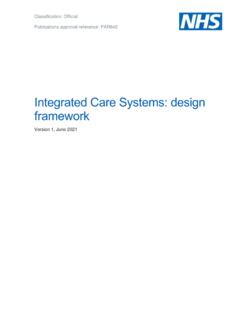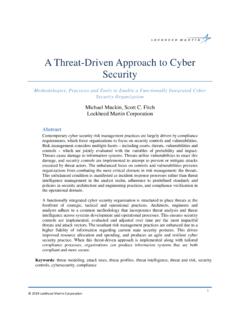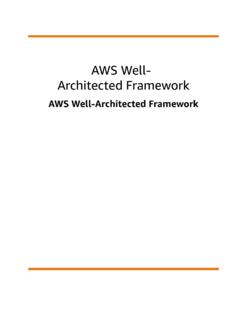Transcription of Withdrawn White Paper - NIST
1 Withdrawn White Paper Warning Notice The attached White Paper has been Withdrawn , and is provided solely for historical purposes. It has been superseded by the document identified below. Withdrawal Date February 3, 2022 Original Release Date April 23, 2020 Superseding Document Status Final Series/Number NIST Special Publication 800-218 Title Secure Software Development Framework (SSDF) Version : Recommendations for Mitigating the Risk of Software Vulnerabilities Publication Date February 2022 DOI CSRC URL Additional Information NIST CYBERSECURITY White Paper Mitigating the Risk of Software Vulnerabilities by Adopting a Secure Software Development Framework (SSDF) Donna Dodson Applied Cybersecurity Division Information Technology Laboratory Murugiah Souppaya Computer Security Division Information Technology Laboratory Karen Scarfone Scarfone Cybersecurity Clifton, VA April 23, 2020 This publication is available free of charge from.
2 NIST CYBERSECURITY White Paper MITIGATING THE RISK OF SOFTWARE APRIL 23, 2020 VULNERABILITIES BY ADOPTING AN SSDF ii Abstract Few software development life cycle (SDLC) models explicitly address software security in detail, so secure software development practices usually need to be added to each SDLC model to ensure the software being developed is well secured. This White Paper recommends a core set of high-level secure software development practices called a secure software development framework (SSDF) to be integrated within each SDLC implementation. The Paper facilitates communications about secure software development practices among business owners, software developers, project managers and leads, and cybersecurity professionals within an organization. Following these practices should help software producers reduce the number of vulnerabilities in released software, mitigate the potential impact of the exploitation of undetected or unaddressed vulnerabilities, and address the root causes of vulnerabilities to prevent future recurrences.
3 Also, because the framework provides a common vocabulary for secure software development, software consumers can use it to foster communications with suppliers in acquisition processes and other management activities. Keywords secure software development; secure software development framework (SSDF); secure software development practices; software acquisition; software development; software development life cycle (SDLC); software security. Disclaimer Any mention of commercial products or reference to commercial organizations is for information only; it does not imply recommendation or endorsement by NIST, nor does it imply that the products mentioned are necessarily the best available for the purpose. Additional Information For additional information on NIST s Cybersecurity programs, projects and publications, visit the Computer Security Resource Center. Information on other efforts at NIST and in the Information Technology Laboratory (ITL) is also available.
4 Comments on this publication may be submitted to: National Institute of Standards and Technology Attn: Computer Security Division, Information Technology Laboratory 100 Bureau Drive (Mail Stop 8930) Gaithersburg, MD 20899-8930 Email: All comments are subject to release under the Freedom of Information Act (FOIA). NIST CYBERSECURITY White Paper MITIGATING THE RISK OF SOFTWARE APRIL 23, 2020 VULNERABILITIES BY ADOPTING AN SSDF iii Acknowledgments The authors wish to thank all of the individuals and organizations who provided comments on the preliminary ideas and drafts, particularly BSA | The Software Alliance, the Information Security and Privacy Advisory Board (ISPAB), and the members of the Software Assurance Forum for Excellence in Code (SAFECode). The authors also greatly appreciate the thoughtful public comments submitted by many organizations and individuals, including the Administrative Offices of the.
5 Courts, The Aerospace Corporation, BSA | The Software Alliance, Capitis Solutions, the Consortium for Information & Software Quality (CISQ), HackerOne, Honeycomb Secure Systems, iNovex, Ishpi Information Technologies, Juniper Networks, Medical Imaging & Technology Alliance (MITA), Microsoft, Naval Sea Systems Command (NAVSEA), the National Institute of Standards and Technology (NIST), Northrop Grumman, Office of the Undersecretary of Defense for Research and Engineering, RedHat, SAFECode, and the Software Engineering Institute (SEI). Audience There are two primary audiences for this White Paper . The first is software producers ( , commercial-off-the-shelf [COTS] product vendors, government-off-the-shelf [GOTS] software developers, custom software developers) regardless of size, sector, or level of maturity. The second is software consumers, both federal government agencies and other organizations.
6 Readers of this document are not expected to be experts in secure software development in order to understand it, but such expertise is required to implement its recommended practices. Personnel within the following Workforce Categories and Specialty Areas from the National Initiative for Cybersecurity Education (NICE) Cybersecurity Workforce Framework [1] are most likely to find this publication of interest: Securely Provision (SP): Risk Management (RSK), Software Development (DEV), Systems Requirements Planning (SRP), Test and Evaluation (TST), Systems Development (SYS) Operate and Maintain (OM): Systems Analysis (ANA) Oversee and Govern (OV): Training, Education, and Awareness (TEA); Cybersecurity Management (MGT); Executive Cyber Leadership (EXL); Program/Project Management (PMA) and Acquisition Protect and Defend (PR): Incident Response (CIR), Vulnerability Assessment and Management (VAM) Analyze (AN): Threat Analysis (TWA), Exploitation Analysis (EXP) Trademark Information All registered trademarks or trademarks belong to their respective organizations.
7 NIST CYBERSECURITY White Paper MITIGATING THE RISK OF SOFTWARE APRIL 23, 2020 VULNERABILITIES BY ADOPTING AN SSDF 1 1 Introduction A software development life cycle (SDLC)1 is a formal or informal methodology for designing, creating, and maintaining software (which includes code built into hardware). There are many models for SDLCs, including waterfall, spiral, agile, and development and operations (DevOps). Few SDLC models explicitly address software security in detail, so secure software development practices usually need to be added to and integrated within each SDLC model. Regardless of which SDLC model is used to develop software, secure software development practices should be integrated throughout it for three reasons: to reduce the number of vulnerabilities in released software, to mitigate the potential impact of the exploitation of undetected or unaddressed vulnerabilities, and to address the root causes of vulnerabilities to prevent future recurrences.
8 Most aspects of security can be addressed at multiple places within an SDLC, but in general, the earlier in the SDLC that security is addressed, the less effort and cost is ultimately required to achieve the same level of security. This principle, also known as shifting left, is critically important regardless of the SDLC model. There are many existing documents on secure software development practices, including those listed in the References section. This White Paper does not introduce new practices or define new terminology; instead, it describes a subset of high-level practices based on established standards, guidance, and secure software development practice documents. These practices, collectively called a secure software development framework (SSDF), should be particularly helpful for the target audiences to achieve secure software development objectives. Note that these practices are limited to those that bear directly on secure software development ( , securing the development infrastructure or pipeline itself is out of scope).
9 This White Paper is intended to be a starting point for discussing the concept of an SSDF and therefore does not provide a comprehensive view of SSDFs. Future work may expand on the material in this White Paper , potentially covering topics such as how an SSDF may apply to and vary for different software development methodologies and how an organization can transition from using just their current software development practices to also incorporating the practices specified by the SSDF. It is likely that future work will primarily take the form of use cases so that the insights will be more readily applicable to certain types of development environments. This White Paper expresses secure software development practices but does not prescribe exactly how to implement them. The focus is on implementing the practices rather than on the tools, techniques, and mechanisms used to do so.
10 For example, one organization might automate a particular step, while another might use manual processes instead. Advantages of specifying the practices at a high level include the following: Can be used by organizations in any sector or community, regardless of size or cybersecurity sophistication Can be applied to software developed to support information technology (IT), industrial control systems (ICS), cyber-physical systems (CPS), or the Internet of Things (IoT) 1 Note that SDLC is also widely used for system development life cycle. All usage of SDLC in this White Paper is referencing software, not systems. NIST CYBERSECURITY White Paper MITIGATING THE RISK OF SOFTWARE APRIL 23, 2020 VULNERABILITIES BY ADOPTING AN SSDF 2 Can be integrated into any existing software development workflow and automated toolchain; should not negatively affect organizations that already have robust secure software development practices in place Makes the practices broadly applicable, not specific to particular technologies, platforms, programming languages, SDLC models, development environments, operating environments, tools, etc.
















